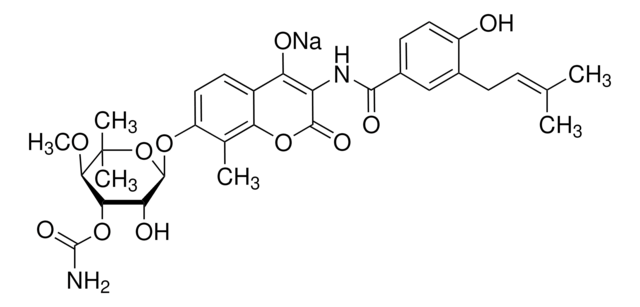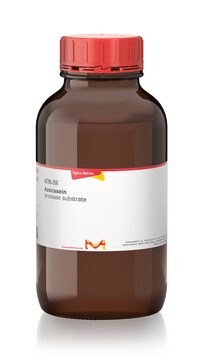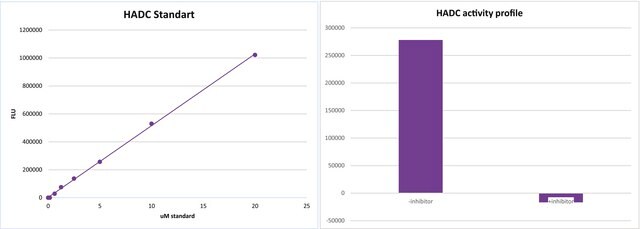Wszystkie zdjęcia(1)
Key Documents
D0690
DNA Gyrase from Escherichia coli
aqueous glycerol solution
Zaloguj sięWyświetlanie cen organizacyjnych i kontraktowych
About This Item
Polecane produkty
pochodzenie biologiczne
Escherichia coli
Poziom jakości
Postać
aqueous glycerol solution
masa cząsteczkowa
~374 kDa
stężenie
≥2 unit/μL
metody
cell based assay: suitable
Zastosowanie
cell analysis
Warunki transportu
dry ice
temp. przechowywania
−70°C
informacje o genach
Escherichia coli K12 ... gyrA(946614) , gyrB(948211)
Zastosowanie
DNA gyrase from Escherichia coli has been used in a study to investigate a comparative proteomic approach to better define Deinococcus nucleoid specificities. DNA gyrase from Escherichia coli has also been used in a study to investigate the role of the DnaK-ClpB bichaperone system in DNA gyrase reactivation.
Działania biochem./fizjol.
DNA gyrase is supplied as an A2B2 holoenzyme. The molecular mass of subunit A is 97 kDa and that of subunit B is 90 kDa. It catalyzes the ATP-dependent introduction of negative supercoils into relaxed DNA. DNA gyrase has been successfully converted into a type II topoisomerase by mutagenesis experiments.
Can be used to supercoil plasmids.
Definicja jednostki
One unit of gyrase activity will supercoil 0.5 micrograms of pBR-322 DNA in 30 minutes at 37 °C.
Inne uwagi
Solution in 50% Glycerol containing Tris buffer, DTT and EDTA.
This page may contain text that has been machine translated.
Kod klasy składowania
10 - Combustible liquids
Klasa zagrożenia wodnego (WGK)
WGK 1
Temperatura zapłonu (°F)
Not applicable
Temperatura zapłonu (°C)
Not applicable
Certyfikaty analizy (CoA)
Poszukaj Certyfikaty analizy (CoA), wpisując numer partii/serii produktów. Numery serii i partii można znaleźć na etykiecie produktu po słowach „seria” lub „partia”.
Masz już ten produkt?
Dokumenty związane z niedawno zakupionymi produktami zostały zamieszczone w Bibliotece dokumentów.
S C Kampranis et al.
Proceedings of the National Academy of Sciences of the United States of America, 93(25), 14416-14421 (1996-12-10)
DNA gyrase is unique among topoisomerases in its ability to introduce negative supercoils into closed-circular DNA. We have demonstrated that deletion of the C-terminal DNA-binding domain of the A subunit of gyrase gives rise to an enzyme that cannot supercoil
Alix Pantel et al.
Antimicrobial agents and chemotherapy, 56(4), 1990-1996 (2012-02-01)
Fluoroquinolone (FQ) resistance is emerging in Mycobacterium tuberculosis. The main mechanism of FQ resistance is amino acid substitution within the quinolone resistance-determining region (QRDR) of the GyrA subunit of DNA gyrase, the sole FQ target in M. tuberculosis. However, substitutions
Magali Toueille et al.
Journal of proteomics, 75(9), 2588-2600 (2012-03-27)
Compared to radiation-sensitive bacteria, the nucleoids of radiation-resistant Deinococcus species show a higher degree of compaction. Such a condensed nucleoid may contribute to the extreme radiation resistance of Deinococcus by limiting dispersion of radiation-induced DNA fragments. Architectural proteins may play
Teresa Lara-Ortíz et al.
Canadian journal of microbiology, 58(2), 195-199 (2012-01-24)
In Escherichia coli cells, an increase in temperature induces immediate DNA relaxation, followed by the fast recovery of DNA supercoiling. DNA gyrase, proteins synthesized during heat stress, and chaperone DnaK have been proposed to participate in this recovery. However, the
Valentina Monica et al.
Lung cancer (Amsterdam, Netherlands), 79(3), 228-235 (2013-01-02)
Thymic epithelial tumors include several entities with different biologic behavior. Chemotherapy is indicated in advanced disease, but limited data exist on gene expression correlation with the response to chemotherapeutic agents. A series of 69 thymic neoplasms (7 A-, 6 AB-
Nasz zespół naukowców ma doświadczenie we wszystkich obszarach badań, w tym w naukach przyrodniczych, materiałoznawstwie, syntezie chemicznej, chromatografii, analityce i wielu innych dziedzinach.
Skontaktuj się z zespołem ds. pomocy technicznej







